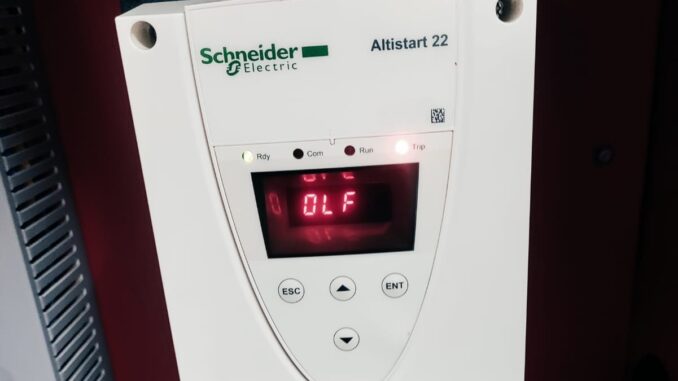
The OLF fault code on the ATS22 Soft Starters indicates an Overload Fault. This fault occurs when the motor or the soft starter exceeds its thermal capacity or set operating parameters, which can damage the equipment if not addressed. Below is a comprehensive and detailed explanation of what the OLF fault code means, its potential causes, and the steps to resolve it.
What is an OLF Fault Code?
The OLF (OverLoad Fault) is a protective feature built into the ATS22 soft starter to safeguard the motor and connected equipment. It is triggered when the motor draws excessive current for an extended period, causing overheating or stress beyond the defined limits set in the starter’s configuration.
Potential Causes of the OLF Fault
Several factors can trigger the OLF fault code, including:
- Prolonged Overcurrent:
- The motor is operating under a higher load than its design capacity, such as during heavy machinery operations.
- Incorrect Parameter Settings:
- Misconfigured current settings or ramp-up profiles in the ATS22 soft starter can lead to premature triggering of the fault.
- Motor Issues:
- A damaged or improperly sized motor may draw more current than expected.
- High Ambient Temperature:
- Excessive heat in the operating environment can contribute to faster overheating.
- Blocked Ventilation:
- Inadequate cooling of the soft starter or motor can cause overheating, triggering the OLF fault.
- Mechanical Problems in the Load:
- Jammed or overloaded mechanical components can increase motor current demand.
Resolving the OLF Fault Code
Here are steps to troubleshoot and resolve the OLF fault on ATS22 Soft Starters:
- Check the Motor Load:
- Inspect the motor and attached load to ensure it is within the motor’s rated capacity. Adjust or reduce the load as needed.
- Verify Parameter Settings:
- Confirm that the overload protection settings match the motor’s rated current. This can usually be done through the ATS22’s configuration menu.
- Inspect the Motor:
- Ensure the motor is in good condition, appropriately sized for the application, and free of damage or excessive wear.
- Improve Ventilation:
- Ensure proper airflow around the soft starter and motor to prevent overheating. Clean or replace blocked vents.
- Examine the Ambient Environment:
- Ensure that the operating temperature is within the soft starter’s specified range.
- Address Mechanical Issues:
- Investigate and resolve any issues with the connected load, such as misalignment, blockages, or excessive friction.
Preventative Measures
To minimize the chances of encountering the OLF fault in the future:
- Perform regular maintenance on the motor, starter, and connected equipment.
- Monitor operating temperatures and current levels during motor operation.
- Periodically review and update configuration settings to align with operational needs.
- Use external cooling systems if operating in high-temperature environments.
By understanding the OLF fault code on the ATS22 soft starter and following these troubleshooting steps, you can ensure smooth operation and longevity for your motor and soft starter.